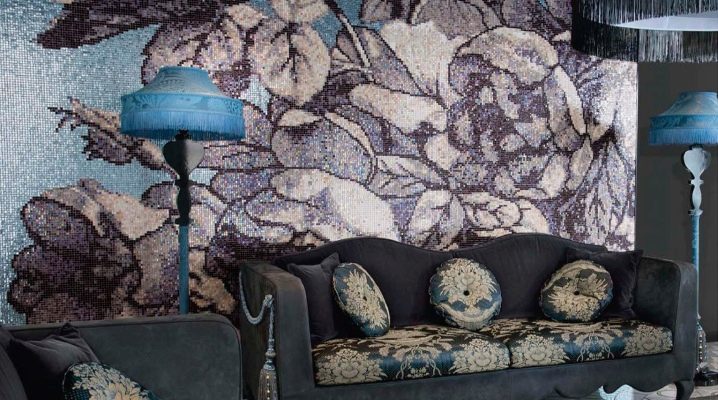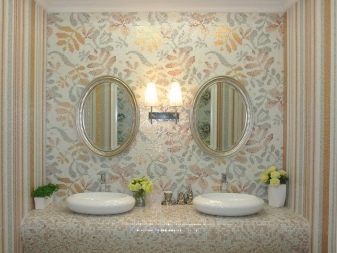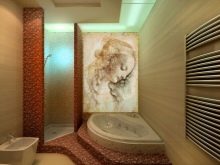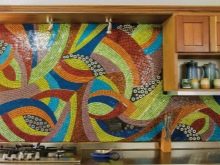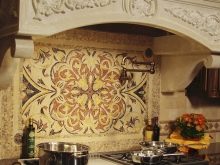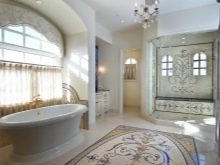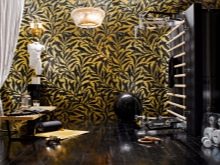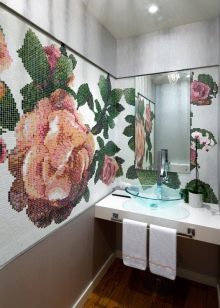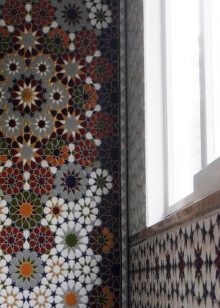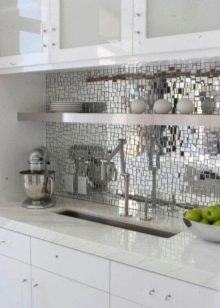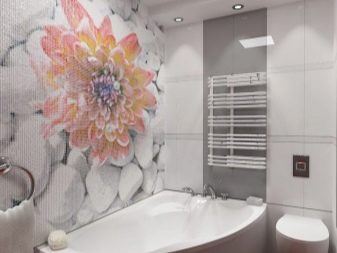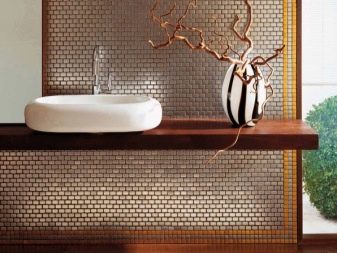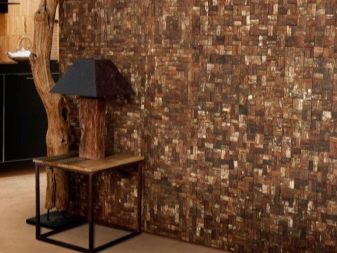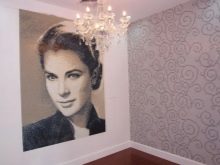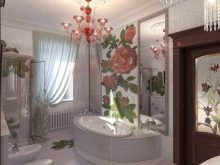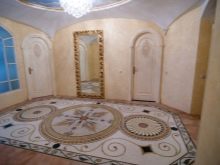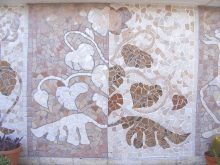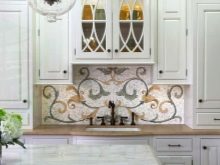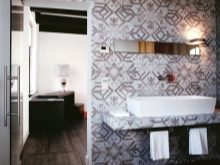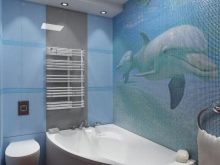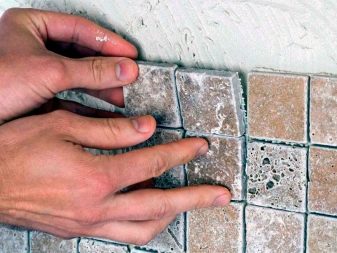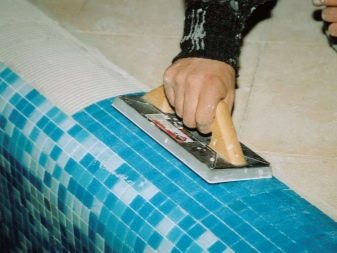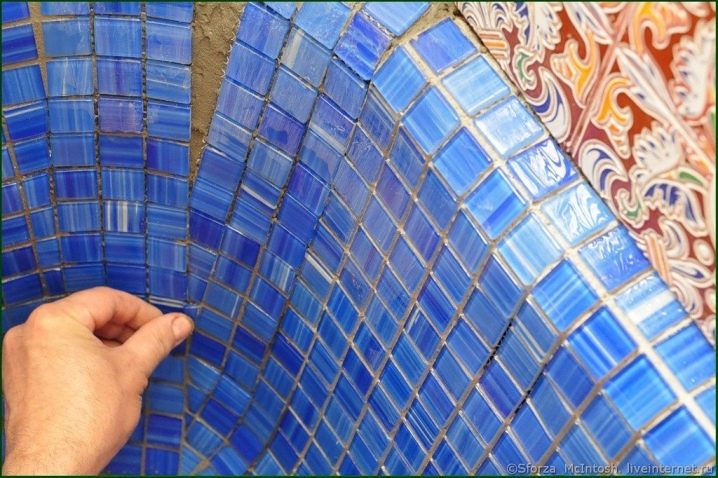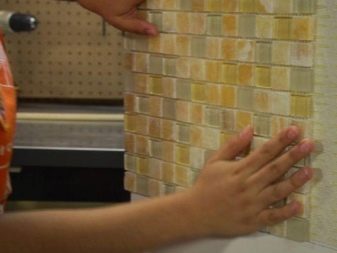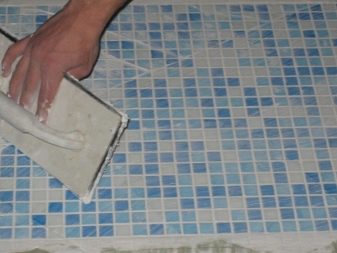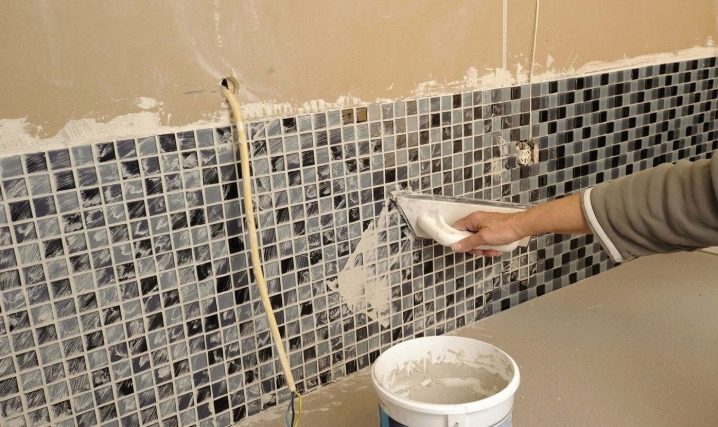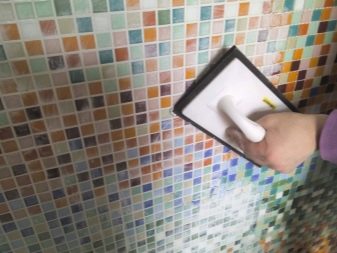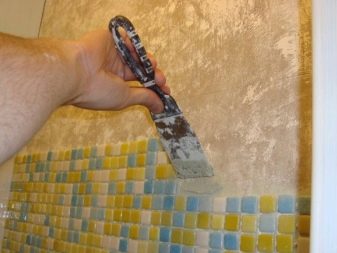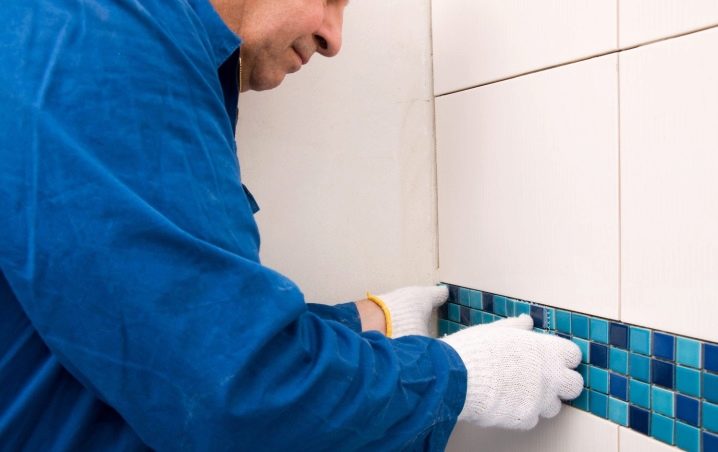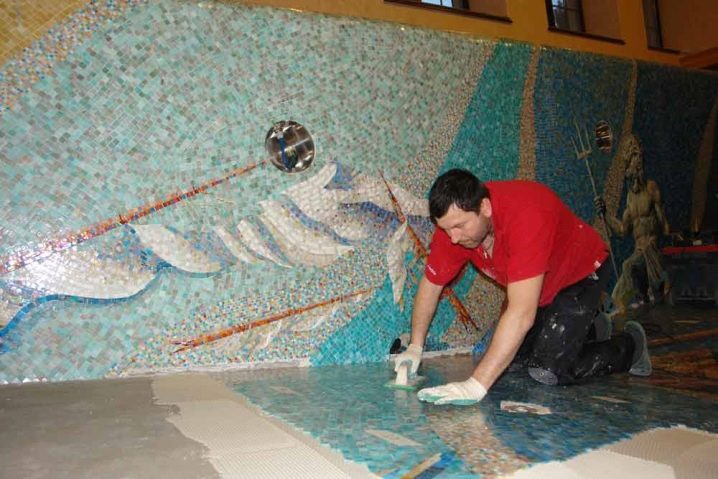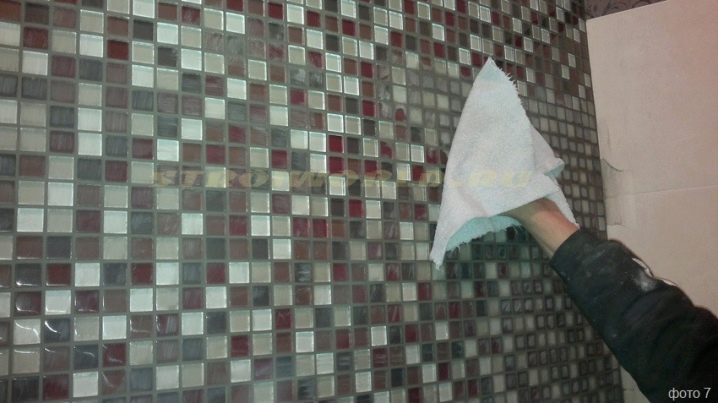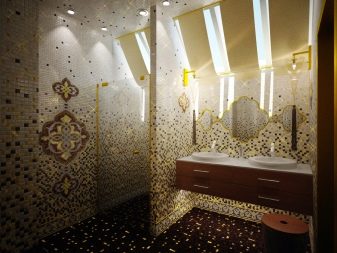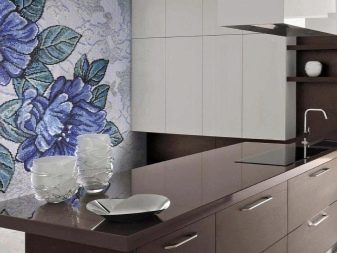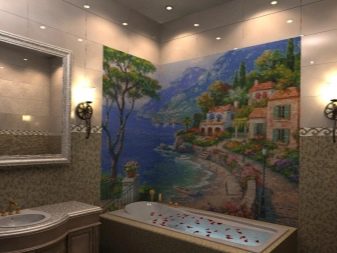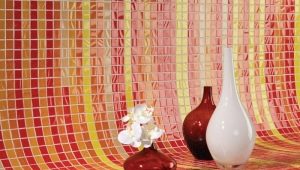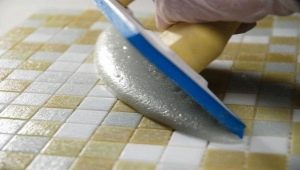Mosaic panel: types of materials and methods of laying
The mosaic panel, assembled from multi-colored mosaic elements, is a highly artistic decorative object. It can add zest and originality to the interior, focus on something specific or visually change the proportions of the room.
The panel can be used on the floor, imitating an intricate carpet, or on the wall as a copy of a portrait, a photograph, a picture of a famous artist, or a frame from a favorite movie.
Special features
Mosaic panels have undeniable advantages in the operation, such as high resistance to environmental influences, durability, aesthetics, durability and color saturation. It is a universal finishing material that is ideal for use on surfaces of any curvature and configuration. Recently, floor mosaic panels made of natural stone or split tiles are becoming more and more popular.
For the purpose of transferring smoothness of color transitions and detailing the finest elements, mosaic pieces of the smallest size are used. This creates an effect of image integrity and saturation of the color palette. With this technique, you can create an artistic masterpiece not only on the wall, ceiling, and even the floor, but also be used to decorate furniture surfaces.
Such an interior will not be overlooked, and if a mirrored mosaic is used in the panel’s design, the space in the room will be played with light and shadows from reflected light and furnishings. The location of such a mosaic panel can be completely different - it is a bath, a bathroom, a kitchen, a pool, and a living room.
It is worth noting that experience with mosaic is very important because it is very difficult to lay and does not forgive even minor errors. The first step to a successful layout is a perfectly prepared, smooth and even surface.
In order that the layer does not flake and subsequently, when applying the plaster, it does not crack and does not deform, you must use cement-sand plaster with an adhesive and reinforcing base.
Kinds
Based on the material of manufacture, mosaic panels are ceramic, glass, stone, mirror, marble, metal and combined types.
According to the technique of execution are divided into artistic and matrix types. For the assembly of artistic mosaic panels use elements of various shapes and sizes, materials and textures. To create a matrix panel, clear schemes with strict pixel grid construction are used. Such a panel of convex polygons is assembled.
Materials
Appearance and characteristics for operation of the mosaic panel depend on the material used.
- Glass mosaic - This is a very practical and versatile to use material. Its embossed surface refracts light, thereby creating additional volume and expressiveness. In addition, it has a number of enviable qualities, such as water resistance, fire safety, hygiene, resistance to deformation.
- Smalt comes from Murano glass, has the same brightness, durability and opacity. It is made of glass pounded into a powder with the addition of dyes.The surface of smalt has both glossy and matte with a glow effect.
- Mirror tile (one of the options of glass) is used only as a background. Due to the ability of reflection gives a visual change in the proportions of the room. It has a number of significant drawbacks: brittleness, high susceptibility to deformation and intolerance to constant humidity.
- Ceramic - ideal for all surfaces and operating conditions. It has an extensive color and texture range. It is resistant to frost, moisture, chemicals and wear.
- Stone - The most ancient way to decorate walls and floors. Such a mosaic is often produced in the form of modules on a grid, since they are easier to stack. It has a diverse combination of qualities that depend on the properties of the stones used in it, for example, sandstone is porous and is not suitable for finishing an apron in the kitchen, and marble easily absorbs dirt and therefore requires periodic polishing.
- Metallic mosaic began its existence quite recently. For its production using aluminum, stainless steel, copper, rarely used pollination with brass, bronze, silver and gold.With scarce colors has a large range of textures. It is produced only modularly on a rubber backing, due to which it does not require perfect flatness of the surface.
- Wooden the mosaic is made of hardwood veneer. In most cases, a mixture of veneer from different tree species is used for a variety of colors, less often they resort to more interesting solutions, for example, cross sections of a tree trunk. Such an original mosaic fits into the interior of various styles: from loft to hi-tech. For a greater effect, the structure of the surface is betrayed by laying the mosaic under a different slope relative to the surface.
Variants of drawings
To date, the imagination of designers has no limits in the application of mosaic tiles. It is used almost everywhere: from the usual decor of the rooms to the exclusive decoration of furniture.
The variation of mosaic panel paintings is also great and can copy folk, antique, classical, ethnic ornaments and motifs, canvases by famous artists, photos, children's pictures, stills from films, inscriptions, imitate textile carpets, animal skins and much more.This abundance is limited only by fantasy and financial opportunities.
The mosaic panel with ease depicts both simple and complex plots, as well as floral, heraldic and even geometric patterns. Mosaics for creating such a panel have the form of regular convex polygons. There are several options.
- Chaotic styling - This is an arbitrary assembly of small parts of any colors and shapes. The result is a pockmarked or one-colored surface. The application of the scheme such installation does not require.
- The repeat method of motive. It is based on a simple pattern (stripes, waves, geometric variations) with repeating elements and is laid out over the entire area of the working surface. Suitable for self-styling.
- Graphic drawing. The simplest version of the picture, which uses few colors of the tile, mainly of an achromatic scale.
- Concentric pattern. It is based on a point around which a symmetrical composition is created with identical lines and elements repeating along a circle.
- Picture. The complex process of recreating the image of the pixel principle.It requires a finished sketch and minimal artistic skills, patience and endurance. The result will pay back the expended forces.
- Local insertion method. This is a lightweight version, when a picture is created by a single display of simple elements on a uniform background, for example, a dolphin or a dragon.
Styling methods
There are two ways of laying: direct and reverse.
When direct laying the image laid out directly on the surface and fixed in the plaster layer.
In the opposite way of laying, the template is covered with a transparent self-adhesive film or paper base, on which the mosaic fragments are laid down with the front side. After the panel is completely frozen, the paper is soaked with a damp sponge, and its remains are removed with a soft cloth moistened with ethyl alcohol or a varnish solvent.
How to collect your own hands?
For many centuries, mosaic panels do not lose their relevance when decorating various surfaces. Over time, laying mosaic became more accessible and diverse, which helps to create a truly unique interior.
At professional assembly of a panel of mosaics of this size, an almost indistinguishable version of a portrait, picture or carpet is obtained.
Under the manufacture of mosaic refers to the independent production of all its components from the base to the elements of the set. And laying involves the creation of panels from the finished set of factory production. Such sets include everything you need from mosaic elements to the sketch of the future panel. This option is more in demand because it does not require any artistic abilities.
The direct stacking method is to lay the image face up. It is better to display the panel on a horizontal surface for ease of operation. Elements of the panel are glued to the grid of fiberglass, and then transferred to the planned location. The seams are rubbed off after fixing the finished panel on the surface.
This method of laying is suitable only for flat surfaces, otherwise the image is deformed at bends.
For rooms with high humidity, for example, in the hammam, silicone glue should be used, in other cases, the usual tile solution will do.
First of all, you need to make a drawing of the future product, this will help a small workshop.
In order to realize the conceived work of fantasy, you should decide on a drawing, then digitize it and with the help of a computer program develop a diagram of the future panel. After the sketch is received, it is necessary to choose what the size of the mosaic should be, and determine its color palette.
Laying mosaic has some tricks.
- To prepare the surface, use a grinder with a bowl-shaped circle and sandblasting. The result should be a flat and rough surface.
- This method of laying is suitable only for a perfectly degreased surface.
- Complete absence on the basis of any extraneous traces of rust, rubber, cement mortar or other origin.
- Grout should not contain sand to avoid damage to mosaic elements. After hardening, traces of grout should be removed with a soft, damp cloth and polished with the same cloth, but dry and completely clean.
Reverse styling is convenient for use on curved and curved surfaces.
For this laying, a drawing is used - a template, which is covered with a transparent self-adhesive film with an adhesive side up, and the mosaic fragments are laid out face down on it. The protective film is removed as the display of mosaic elements.
To complete the installation, the resulting panel is divided into small parts, each of which is alternately transferred to the base. Pre-base coated with glue. Before transferring a part of the panel, it is better to number it in order not to confuse the sequence of its fragments. Fastening should be done with gentle pressure, so that the glue completely covers the surface of the clutch. Regarding the sizes of the parts into which the panel is cut, they must be small so that the mosaic does not crumble and is not damaged, does not change its position.
In the first embodiment, after the panel is finally frozen, the self-adhesive film is removed. When using the second option, the paper is soaked with a damp sponge, and the remnants of egg white are cleaned with a sponge of average humidity.
Grouting and polishing is carried out similarly with a direct dial.It is worth remembering that when you reverse the laying of the image on the panel turns out to be a mirror relative to the picture - template.
The assembly and layout of the mosaic panel is done manually. This is a complex and painstaking process that requires minimal experience, great patience and perseverance. Epoxy materials should be used to secure the mosaic panel to the base. And the use of epoxy grout will create an additional reinforcing mesh. It will provide additional protection for the mosaic panel from accidental chips.
The simplest way of displaying the panel is the assembly of ready-made blanks, when applying the selected pattern follows the principle of photo printing. This technology has an undeniable advantage - it is the speed of assembly and the efficiency of obtaining interesting modern canvases.
You can buy ready-made kits of mosaic panels both in company stores and order an individual sketch in the factory from the manufacturer.
Beautiful examples in the interior
There is a stylistic division into Roman, ceramic, Venetian, Moroccan. For example, the Moroccan style is characterized by the use of orange, brown, blue, blue, yellow, white and dark green colors.
Therefore, if you wish, you can embody an oriental tale in the interior with the help of ornaments and romance with the help of delicate flowers or a picture of the sunset on the sea coast.
It is worth considering that the size of the mosaic depends on the appearance of the panel. The larger the pieces of the mosaic, the rougher the panel will look and have the effect of brush strokes, and the smaller the pieces, the more realistic the picture can be collected and reproduced more color transitions and shades.
See how to lay out the mosaic panel in the video below.
